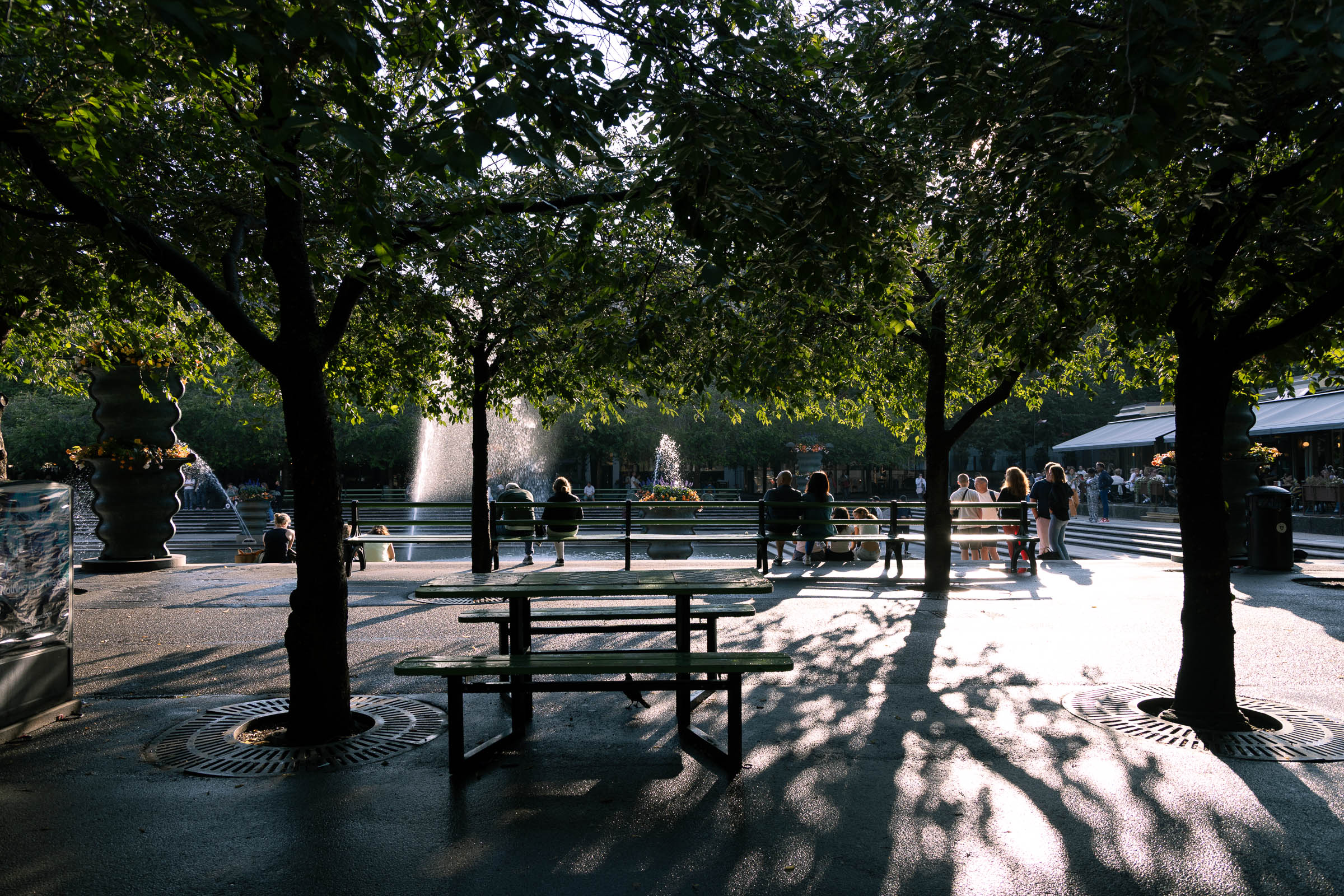Get your questions about visiting Stockholm answered. From practical travel tips to local customs, this guide helps you plan your trip to Sweden’s capital.
Getting around Stockholm
You have four main options: the Arlanda Express train (about 18 minutes, fastest/most expensive), airport coaches (45 minutes, mid-price), local buses and commuter trains (around 1 hour, cheapest), or taxi/ride-hailing (typically 35–45 minutes depending on traffic; many companies offer fixed fares). All of these bring you to central Stockholm: Arlanda Express to Stockholm Central Station, airport coaches to Cityterminalen next to Central Station, and the commuter train to Stockholm City/Central. For details on all Stockholm airports and transport options, see our complete guide on how to travel to and from Arlanda Airport.
Stockholm’s public transport (SL) uses one ticket covering the metro (Tunnelbana), buses, trams, commuter trains, and some ferries. You don’t need a special card: buy tickets in the SL app or tap a contactless bank card or mobile wallet at the gates/readers to get a 75-minute single ticket. Single tickets can add up, so consider a 24-hour, 72-hour, or 7-day travelcard if you’re sightseeing. If you prefer a plastic card, you can buy an SL smart card (one-time fee 50 SEK) and load tickets onto it. Read our detailed guide to getting around Stockholm for ticket types and money-saving tips.
Yes, Stockholm’s metro is straightforward to navigate. There are only three (green, red, and blue) all clearly marked with color coding and clear signs in both Swedish and English. On-board announcements are usually in Swedish, but screens and the SL app make navigation easy for non-Swedish speakers. Most tourist attractions are within walking distance of a metro station.
Yes, but only partially. Your SL travel ticket covers the city’s commuter ferries and (year-round) on Waxholmsbolaget boats between central Stockholm and Vaxholm (a defined “SL area” with 43 piers). For most other archipelago routes, including popular islands like Grinda, Sandhamn, and Fjäderholmarna, you’ll need a separate Waxholmsbolaget ticket. During the low season (14 September to 29 April), SL period tickets valid for 30 days or longer are also accepted across all Waxholmsbolaget services. Check our guide to getting to Stockholm archipelago by ferry for complete details on routes and tickets.
Money and payments
Sweden uses Swedish kronor (SEK), not the euro. Most stores and restaurants will not accept euros as payment.
Stockholm is mostly cashless. Most establishments prefer card payment, and many are card-only. You can pay by card everywhere – restaurants, cafés, public transport, and even public toilets and market stalls – so carrying cash is rarely necessary. Visa and Mastercard work everywhere that credit cards are accepted. American Express is accepted in many establishments, such as hotels, museums, grocery stores and many restaurants. Smaller establishments might not accept American Express, so bring a Visa or Mastercard as a backup. Diners Club has limited acceptance. You will rarely need cash, but there are several ATMs (look for signs saying “Bankomat” or “Uttag”) if you prefer to still use cash.
Swish is a local mobile-payment app popular in Sweden, but it requires a Swedish bank account and Mobile BankID, so most visitors can’t use it.
Saunas and swimming
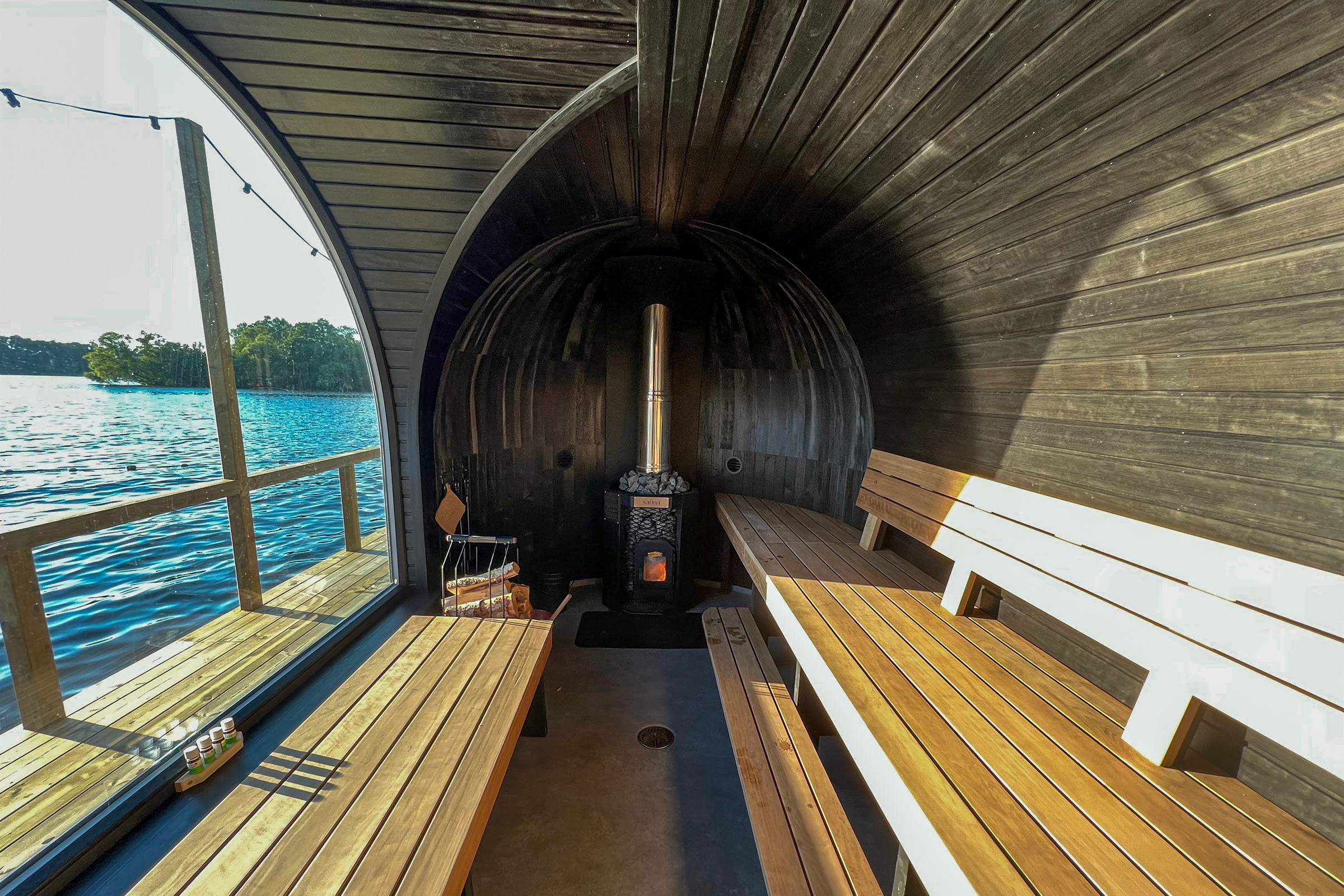
It depends on the venue. Traditional Swedish saunas are enjoyed nude, and in single-gender saunas, swimwear is typically not allowed. Mixed-gender saunas usually require swimwear. Always shower before entering and bring a towel to sit on to protect the wood benches. There’s nothing sexual about nude bathing in Sweden – it’s simply the traditional and more hygienic way. Our guide to the best saunas in Stockholm specifies the dress code for each sauna.
For first-timers who want a comfortable experience without membership requirements, we recommend The Nest Wellness (rooftop spa with sauna and pool in central Stockholm), Centralbadet (historic bathhouse with several sauna types), or Sacred Sauna (guided aufguss ceremonies in a stylish urban setting). If you want the authentic lakeside experience with a cold plunge, try Hellasgården or Tanto bastu. See all options in our complete sauna guide.
Many lakeside saunas are run by associations and mainly serve members, but several offer public sessions each week that you can book. Spa saunas (like Centralbadet, Sturebadet, or The Nest Wellness) are always open to the public with day passes. Always check opening hours and booking requirements in advance. Popular spots, such as Sthlm Sauna Vinterviken’s public sessions, fill up quickly and require advance booking.
They’re the same thing! “Bastu” is simply the Swedish word for sauna. It comes from “badstuga,” meaning bathhouse. When locals say they’re going to the bastu, they mean sauna. Both terms are used interchangeably in Stockholm.
Absolutely! Stockholm has many free public swimming spots throughout the city, from sandy beaches to rocky lakeside jetties. The comfortable swimming season runs June through August, when water temperatures are warmest and daylight lasts long (until 10 pm in June/early July). Brave locals swim year-round (winter swimming is popular), but visitors typically enjoy it most in summer. Check out our guide to the best outdoor swimming spots for specific locations and how to reach them.
Food and dining
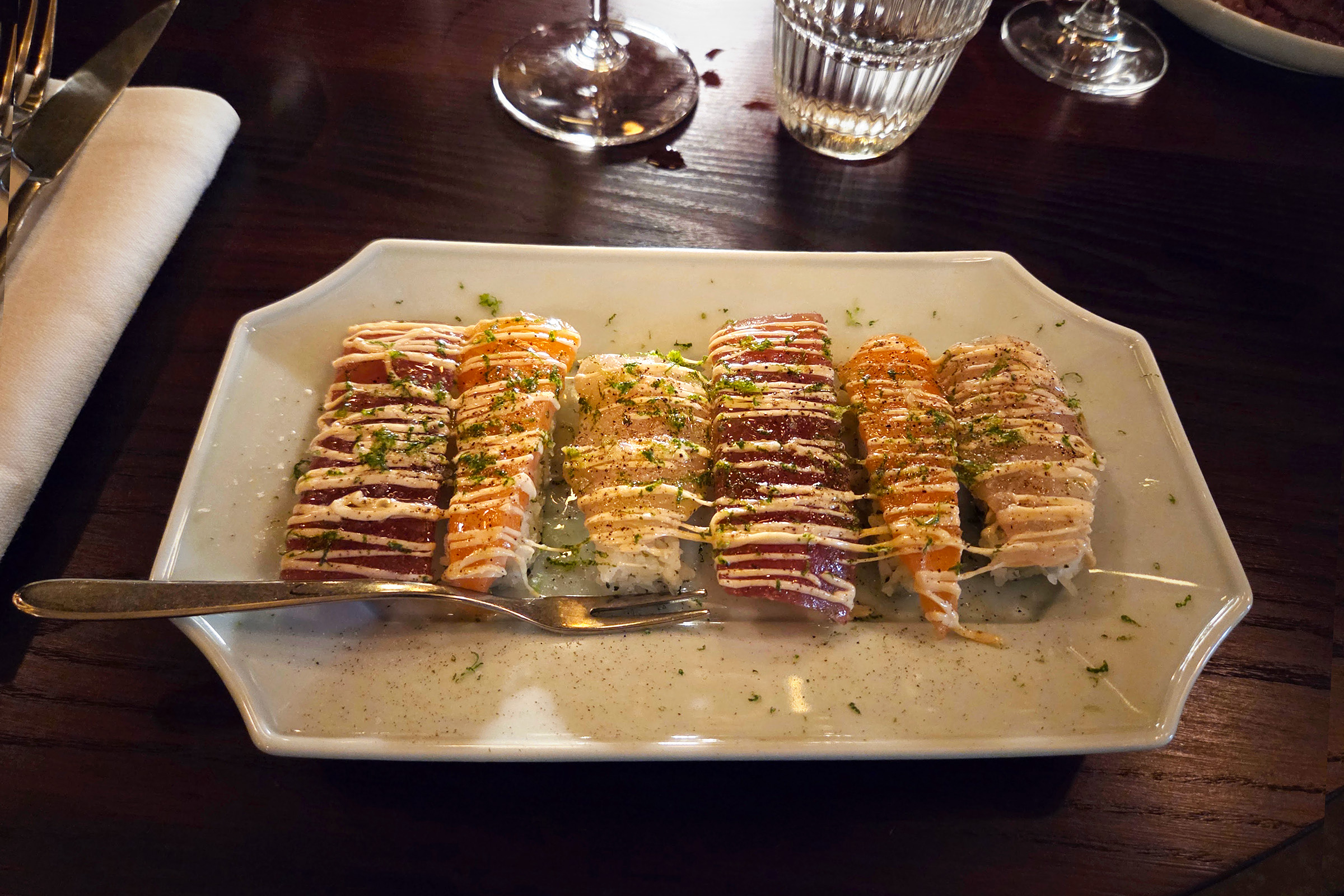
Julbord is Sweden’s traditional Christmas buffet, with staples like meatballs, pickled herring, gravlax, Christmas ham (julskinka), small sausages (prinskorv), and seasonal sides. It’s served at restaurants from mid-November through December. The word literally means “Christmas table.” Think of it as Sweden’s ultimate holiday feast where you sample dozens of traditional dishes in one meal. You’ll find julbord at many hotels and restaurants, usually with advance booking. See our picks for the best julbord in Stockholm.
For traditional Swedish meatballs with creamy sauce, mashed potatoes, lingonberry jam, and pickled cucumber, try established restaurants like Prinsen or Pelikan; both keep the traditional plate on the menu. Meatballs for the People is another good option, with a wider range of meatball styles alongside the classic version. Avoid obvious tourist traps in Gamla Stan. For a broader look at Swedish cuisine, read our guide to Stockholm restaurants for traditional Swedish food, which includes several excellent options for classic dishes.
Most restaurants in Stockholm are open on Sundays, though some have reduced hours or close earlier in the evening. Fine-dining places often close on Sundays or Mondays. Around major public holidays – especially Christmas Eve (Julafton) and Midsummer Eve (Midsommarafton) – expect widespread closures, so check ahead and book if needed. Cafés and casual spots in central, tourist-heavy areas are more likely to keep normal hours on Sundays. Hotel restaurants, restaurant chains, and shopping mall food courts are your safest bet for guaranteed Sunday opening.
For budget meals, look for lunch specials (dagens lunch) at local restaurants; they’re good value and often include salad, bread, and coffee. Food halls like Hötorgshallenand food courts in central malls can be affordable, and takeaway spots and international kitchens (for example Middle Eastern or Asian) are usually cheaper than traditional Swedish restaurants. Supermarkets (ICA, Coop, Hemköp) also sell ready-to-eat meals and salads.
For drinks, check out our budget-friendly bars and pubs guide, which lists places with affordable prices. Also see our guides to affordable breakfast, lunch, and dinner options.
Stockholm has a solid vegan and vegetarian scene, with dedicated restaurants across the city. Södermalm is especially good for plant-based dining. Hermans serves a vegetarian buffet and has a stunning city view, while numerous cafés offer vegan fika options. Most restaurants now include at least one or two plant-based options on their menus as standard. Check our guides to vegan and vegetarian restaurants and vegan cafés for comprehensive listings.
Stockholm has an excellent pizza scene, from traditional Neapolitan-style pizzerias to modern, creative takes. Many places use proper wood-fired ovens and focus on high-quality ingredients. You’ll see Italian styles alongside distinct Swedish takes (such as kebab pizza or even banana-and-curry toppings). For specific recommendations and neighborhood tips, see our best pizza in Stockholm guide.
Tipping isn’t required in Sweden. Prices already include service, and any added service charge will be shown on the bill. Rounding up the total or leaving 5-10% for good service is appreciated but not expected. Many Swedes simply round up to the nearest convenient number. Card terminals may prompt you to add a tip – feel free to select “no tip”, it’s not considered rude. Staff earn proper wages, and tips are a bonus rather than essential income.
Seasonal and weather questions
Stockholm’s Christmas markets typically run from late November until around December 23rd, closing before Christmas Eve (which is the main celebration day in Sweden). The most popular markets are in Gamla Stan (Old Town) and Skansen open-air museum. Opening dates vary slightly each year, so check specific market websites closer to your visit. Read our guide to Stockholm’s best Christmas markets for details on each market and what makes them special.
Yes, Stockholm is a great winter destination, especially during December with Christmas markets and festive lighting. Most museums, restaurants, and attractions operate year-round. Archipelago ferries operate in winter but with fewer departures. Winter is perfect for sauna sessions, cozy cafés, and exploring the city without summer crowds. Expect cold temperatures (often just below freezing) and limited daylight (about 6 hours in mid-December), but the city embraces the season beautifully. Check our winter in Stockholm guide for what to expect.
Stockholm has excellent options for rainy days, from world-class museums to cozy cafés, shopping, and indoor markets. The Vasa Museum, ABBA Museum, and Fotografiska are all impressive indoor attractions. Shopping streets like Hamngatan offer covered shopping, and you could spend hours exploring food halls like Östermalms Saluhall or Hötorgshallen. See our rainy day activity guide for specific recommendations.
Stockholm’s parks burst with golden and red foliage from late September through October. Top spots include Djurgården (try the paths around Rosendals Trädgård), Hagaparken, and waterfront parks like Rålambshovsparken. The archipelago islands also offer stunning autumn scenery with less crowds. For specific locations and timing tips, see our guide to autumn colors in Stockholm and our overview of things to do in Stockholm in autumn.
Summer (June-August) brings long days and late sunsets. Around midsummer it hardly gets dark, with more than 18 hours of daylight and sunsets after 10 pm, creating the famous “white nights.” Temperatures average 20-25°C (68-77°F), perfect for outdoor swimming, archipelago trips, and al fresco dining. This is peak tourist season, so book accommodation early and expect crowds at major attractions. Locals vacation in July, so some businesses may have reduced hours, but most attractions and restaurants stay open. Read our summer in Stockholm guide for seasonal tips and activities.
June through August brings warm weather, endless daylight, and great conditions for swimming and outdoor activities. This is the peak tourist season with higher prices and bigger crowds. May and September have fewer crowds, pleasant weather, and shoulder-season rates. December is especially festive, with Christmas markets and winter lights. April and October are more quiet, and can be chilly with unpredictable weather. See our best time to visit guide for monthly breakdowns.
Stockholm Archipelago

For a one-day trip, Fjäderholmarna is the easiest option – just 25 minutes by ferry from central Stockholm with charming craft shops, restaurants, and easy walking paths. If you want more nature, swimming, and hiking, Grinda provides beautiful trails, swimming spots, and a genuine archipelago feel. When planning the route, plan on roughly 1.5 hours each way on the fast boats. Vaxholm offers a small-town atmosphere with restaurants, cafés, and history at the impressive Vaxholm Fortress. See our complete archipelago guide for routes, timetables, and how to choose.
You can go to Fjäderholmarna by tourist ferries run by Fjäderholmslinjen and Strömma. Boats depart from central Stockholm – typically Skeppsbrokajen in Gamla stan (Fjäderholmslinjen) or Strandvägen by Nybroplan (Strömma). The journey takes just 25 minutes. You can usually buy tickets online or at the quay. During peak season it’s usually a good idea to pre-book tickets, in order to be sure to get on the ferry without having to wait. If you haven’t pre-booked a ticket, expect some ferries to bu fully booked and waiting for the next ferry. Ferries run frequently during summer (May-September) but have limited service off-season. These ferries dock at the main visitor area in Fjäderholmarna, with easy access to restaurants and shops. Our Fjäderholmarna guide has complete visitor information.
It depends what you want. Grinda is closer (1.5 hours by boat from central Stockholm), perfect for hiking, swimming, and has a laid-back nature vibe. Sandhamn is farther (2-3 hours) and offers a livelier atmosphere. Sandhamn has more restaurants, shops, and an active sailing scene – plus stunning beaches, such as the beach, Trouville about a 15–20 minute walk from the harbor. If you have limited time or want more nature than socializing, choose Grinda. If you prefer a busier, resort-like island with great beaches and dining, pick Sandhamn. See our Grinda one-day itinerary for planning tips.
Yes, though with limitations. Waxholmsbolaget runs year-round ferries to several islands, including Vaxholm. However, winter timetables mean fewer departures and occasional time table adjustments due to frozen waterways. Many smaller islands have reduced or no ferry service November-April, and restaurants/facilities may be closed. Islands close to the mainland remain accessible. Vaxholm is reliably accessible even during winter. Grinda has year round traffic but limited departures. A winter visit is a serene and nearly tourist-free experience, as long as you are prepared for cold weather and limited services.
Museums and culture
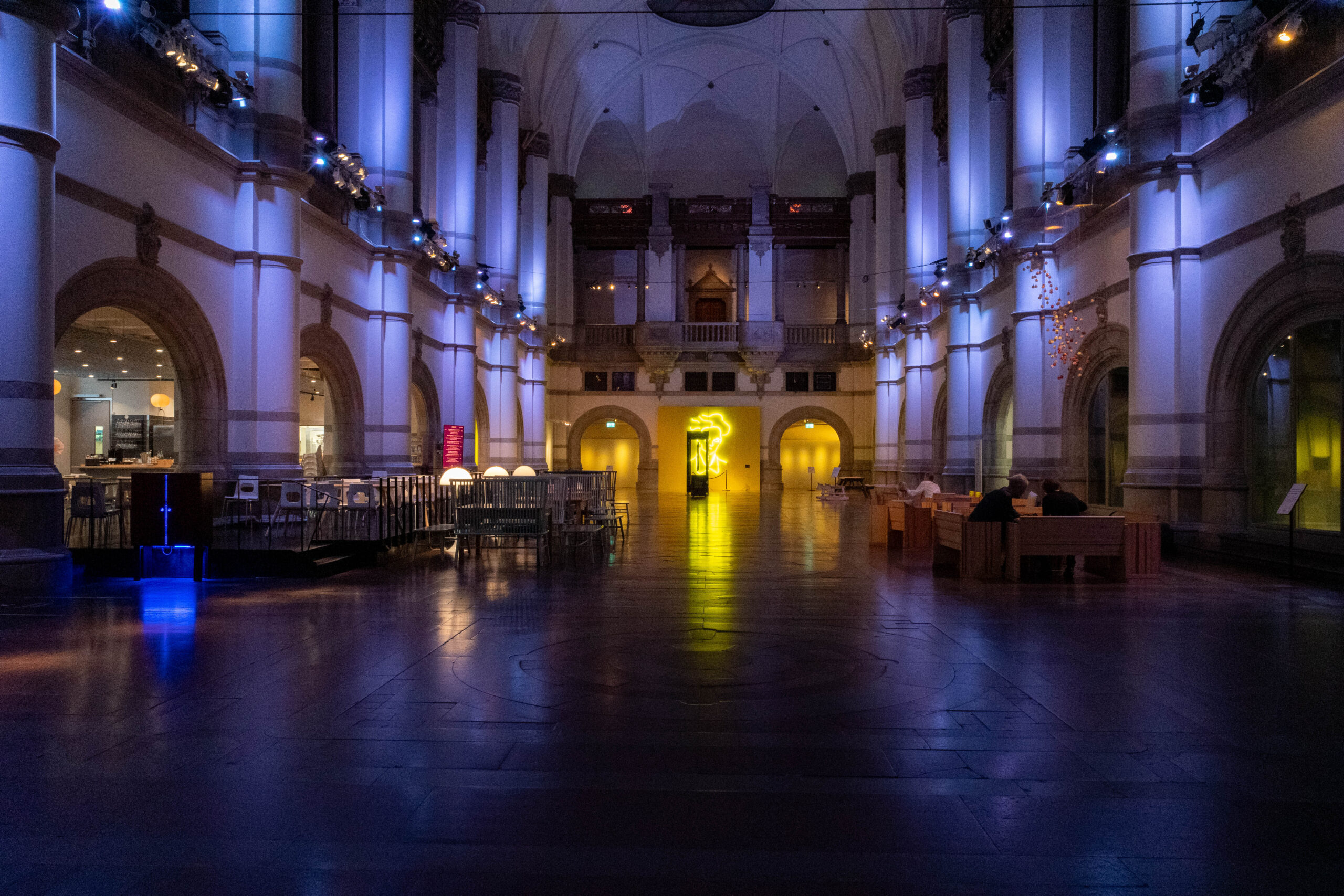
A few Stockholm museums are always free, the Stockholm City Museum (Stadsmuseet) and the National Sports Museum (Riksidrottsmuseet). In 2025, the Swedish Holocaust Museum and ArkDes also offer free admission to their exhibitions. Many others are free at specific times: Nationalmuseum on Thursdays 5 pm–8 pm; Moderna Museet on Fridays 6 pm–8 pm in spring/autumn; Liljevalchs Konsthall on Mondays; and the Jewish Museum on Saturdays 11 am–12 pm. Always check current hours and prices before you go. Our guide to free museums in Stockholm lists all options with opening hours.
The Stockholm Pass (Go City) includes major attractions like the Vasa Museum, Skansen, the Nordic Museum, the Royal Palace, and many others – over 70 attractions total. Whether it’s worth it depends on how many you’ll visit. If you’re planning to see 3+ major paid museums per day, the pass saves money. For a more relaxed pace visiting free museums and fewer paid attractions, individual tickets may be cheaper.
The essential Stockholm experiences include the Vasa Museum (17th-century warship), Gamla Stan (medieval Old Town), the Royal Palace, Skansen open-air museum, Fotografiska photography museum, City Hall (with tower views, in the summer), ABBA The Museum, Djurgården island, the Stockholm archipelago, and the city’s metro art. Each offers something different, from a royal palace and a 17th-century ship to contemporary photography and public art. See our complete top 10 attractions guide with detailed descriptions and visit tips.
Practical visitor information
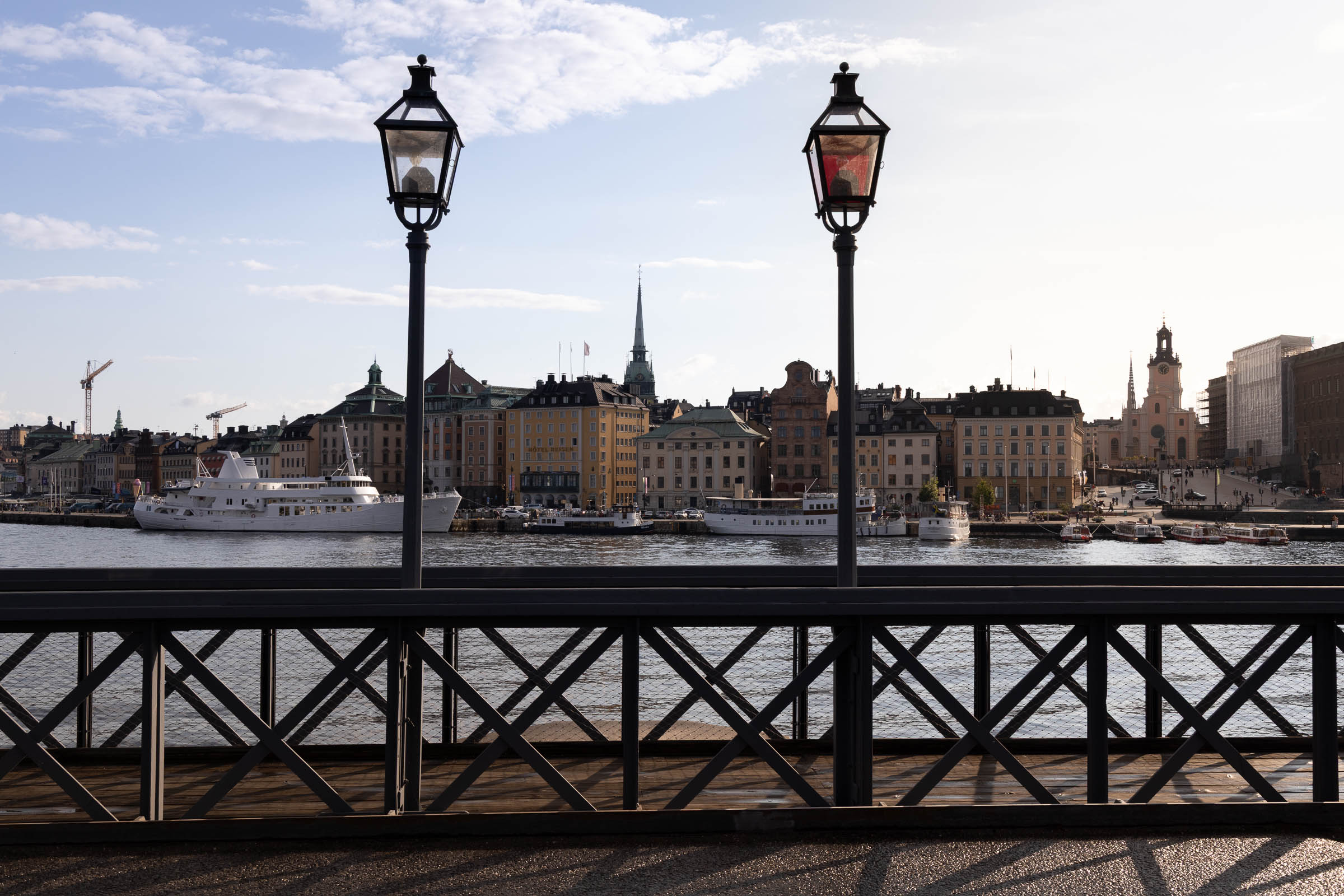
Yes, English proficiency is very good in Stockholm and you can get by with English almost everywhere. Most signs, menus, and tourist information are available in English though smaller, local cafés and restaurants may only have Swedish). And service staff will usually switch to English right away. You’ll have no language problems as an English-speaking tourist.
Three to four days gives you time to see the main attractions without rushing. Day 1: Gamla Stan and the Royal Palace. Day 2: the Vasa Museum and Djurgården. Day 3: modern Stockholm and shopping (Södermalm and Norrmalm). Day 4: a day trip to the archipelago. If you only have two days, prioritize the Old Town and Vasa Museum. Five days allows for a more relaxed pace and deeper exploration. Check our itineraries page for day-to-day plans.
For a first visit, Norrmalm is the most convenient base, close to Stockholm Central Station and many sights. Östermalm is central and upscale, with parks and museums nearby. Södermalm is a trendy neighbourhood, with great restaurants, bars, and nightlife. Gamla stan is atmospheric and very central but busy and pricier; everyday shops are limited and the cobbled streets can be hard on luggage. If you prefer a quieter, local feel still within walking distance of the center, Vasastan is a good for a quieter area with proximity to many restaurants, cafés and bars. If you stay far out in the suburbs, you’ll spend more time commuting. Most tourists find Norrmalm the most convenient base for sightseeing. Read our detailed guide to where to stay in Stockholm for neighborhood comparisons.
Stockholm is in the middle to upper range in prices compared to other European cities. For hotels, dining, and alcohol Stockholm is more expensive than Berlin, Prague and Lisbon, but more affordable than Copenhagen, Oslo and Helsinki. Save money by: eating lunch specials (dagens lunch), picking up some meals from supermarkets, using public transport instead of taxis, visiting free museums, enjoying free outdoor activities like swimming and walking tours, and – if you’re having a drink at home or going for a picnic – buying alcohol at Systembolaget (Sweden’s liquor stores) rather than in bars. A 24-hour SL travelcard makes sense if you’ll take five or more rides in a day. If you ride less than that, single tickets are cheaper. Our Stockholm on a budget section has comprehensive money-saving tips.
Stockholm isn’t known for skyscrapers, but it does have a few tall buildings. Among the highest are Kista Science Tower (124 m, offices), Norra Tornen – Innovationen (about 120 m, residential), and Scandic Victoria Tower (117.6 m, hotel in Kista). The best classic viewpoint you can climb is the Stockholm City Hall tower (106 m), open in summer on timed visits. At Scandic Victoria Tower you can enjoy the 34th-floor sky bar even if you’re not a hotel guest. For another “from-above” experience, SkyView on the Avicii Arena lifts you in a glass gondola to about 85 m. Read our guide to Stockholm’s tallest buildings for architectural history and viewing tips.
Nightlife and going out
Stockholm has an excellent nightlife scene with something for everyone, from trendy cocktail bars to energetic nightclubs and live music venues. The city comes alive on Fridays and Saturday nights. Swedes typically start at a bar or restaurant before going out to a club later during the night (clubs peak around midnight). Many venues close around 3 am, and a few run until 5 am. The drinking age is 18, but many clubs have 20-23+ age restrictions. Cover charges are common at popular venues. Our complete Stockholm nightlife guide covers the best bars, clubs and areas to go out.
Södermalm is Stockholm’s trendiest nightlife area, particularly around Hornstull, Mariatorget, and SoFo (South of Folkungagatan), with hip bars, clubs, and a younger crowd. Stureplan in Östermalm offers upscale clubs and cocktail bars attracting a more dressed-up, affluent scene. Gamla Stan has a lot of tourist-friendly pubs and bars; it’s convenient, though many locals go elsewhere later in the night. For live music and more alternative venues, try Hornstull or areas around Slussen/Mosebacke. Most neighborhoods have their own local bars, but these three areas are where visitors find the most concentrated nightlife action.
Specific venues and restaurants
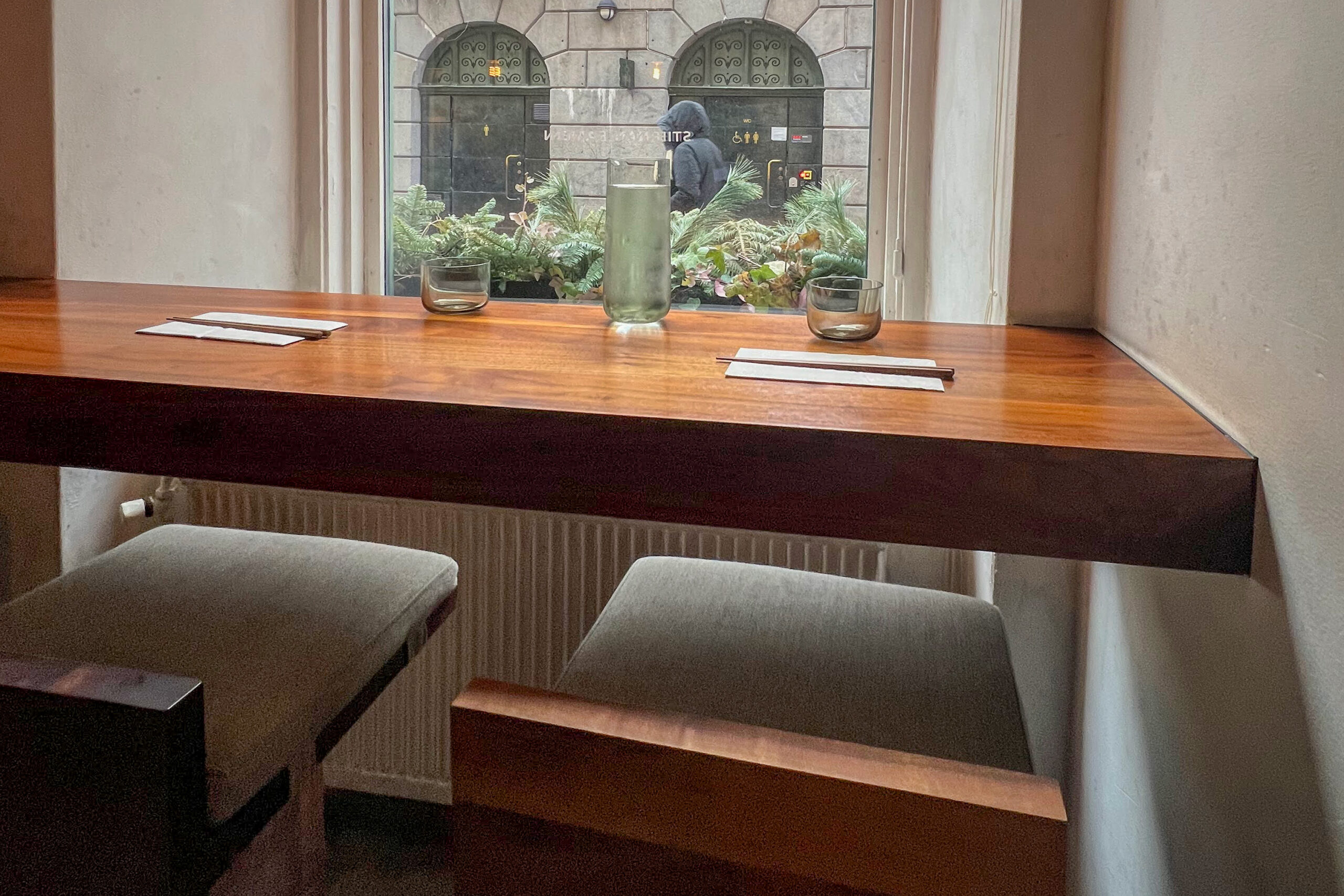
Miyakodori is a Japanese-style izakaya serving yakitori (grilled skewered chicken) and other charcoal-grilled skewers, plus a handful of small plates. It’s located in a cozy setting and offers an authentic Japanese izakaya experience with quality ingredients and skilled preparation. The atmosphere is intimate and the menu focuses on a few Japanese dishes done right rather than trying to do everything. Read our Miyakodori review for menu highlights and tips on what to order.
Prinsen is a classic Stockholm restaurant at Mäster Samuelsgatan in central Stockholm (Norrmalm), just a few minutes walk from Östermalmstorg metro station. It’s been serving traditional Swedish food since 1897 and is a Stockholm institution. Reservations are recommended, especially for dinner and weekends, as it’s popular with both locals and visitors seeking authentic Swedish cuisine in a historic setting. Check our Prinsen review for more details.
Stiernan Ramen serves excellent Japanese ramen in Stockholm’s Old Town. Whether it’s “worth the wait” depends on how much you love ramen and how long the line is. The space is small (about 10–12 seats), so queues are common at peak lunch and on weekends, but they tend to move.. The ramen is among Stockholm’s best, with rich broth and quality ingredients. If there’s a long queue and you’re very hungry, you might prefer to go at off-peak hours or try another time. Note that hours are often limited (frequently lunch-only), so check current opening times before you go. Read our Stiernan Ramen review for details on the experience.
Östermalms Saluhall is Stockholm’s upscale indoor food hall (opened in 1888), perfect for sampling Swedish delicacies. Try the fresh seafood (shrimp, crayfish, gravlax), traditional Swedish cheeses, and quality meats. Several vendors offer sit-down dining where you can enjoy fresh oysters, herring, or a seafood platter. It’s pricier than supermarkets but offers quality and atmosphere. Visit in the afternoon for a more relaxed experience. Learn more about the Östermalm district where the food hall is located.
Stockholm has a thriving specialty coffee scene with excellent independent roasters and cafés throughout the city. For traditional fika (coffee and pastry break), try classic spots like Vete-Katten or Café Pascal. For specialty coffee, seek out Johan & Nyström, Drop Coffee, or Kaffeverket locations. Every neighborhood has its own beloved local café. Our Stockholm coffee guide and guide to best cafés and fika spots have detailed recommendations by area.
Have more questions? Browse our complete Stockholm visitor guide for comprehensive planning information.

